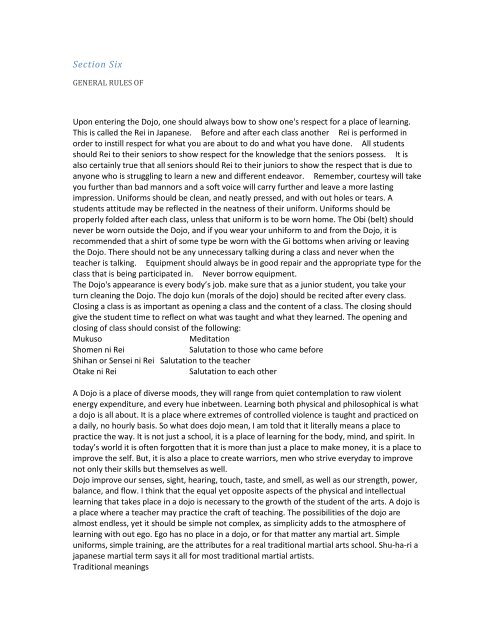Download Student Guide - North Wind Martial Arts & Fitness
Download Student Guide - North Wind Martial Arts & Fitness
Download Student Guide - North Wind Martial Arts & Fitness
You also want an ePaper? Increase the reach of your titles
YUMPU automatically turns print PDFs into web optimized ePapers that Google loves.
Section SixGENERAL RULES OFUpon entering the Dojo, one should always bow to show one's respect for a place of learning.This is called the Rei in Japanese. Before and after each class another Rei is performed inorder to instill respect for what you are about to do and what you have done. All studentsshould Rei to their seniors to show respect for the knowledge that the seniors possess. It isalso certainly true that all seniors should Rei to their juniors to show the respect that is due toanyone who is struggling to learn a new and different endeavor. Remember, courtesy will takeyou further than bad mannors and a soft voice will carry further and leave a more lastingimpression. Uniforms should be clean, and neatly pressed, and with out holes or tears. Astudents attitude may be reflected in the neatness of their uniform. Uniforms should beproperly folded after each class, unless that uniform is to be worn home. The Obi (belt) shouldnever be worn outside the Dojo, and if you wear your unhiform to and from the Dojo, it isrecommended that a shirt of some type be worn with the Gi bottoms when ariving or leavingthe Dojo. There should not be any unnecessary talking during a class and never when theteacher is talking. Equipment should always be in good repair and the appropriate type for theclass that is being participated in. Never borrow equipment.The Dojo's appearance is every body’s job. make sure that as a junior student, you take yourturn cleaning the Dojo. The dojo kun (morals of the dojo) should be recited after every class.Closing a class is as important as opening a class and the content of a class. The closing shouldgive the student time to reflect on what was taught and what they learned. The opening andclosing of class should consist of the following:MukusoMeditationShomen ni ReiSalutation to those who came beforeShihan or Sensei ni Rei Salutation to the teacherOtake ni ReiSalutation to each otherA Dojo is a place of diverse moods, they will range from quiet contemplation to raw violentenergy expenditure, and every hue inbetween. Learning both physical and philosophical is whata dojo is all about. It is a place where extremes of controlled violence is taught and practiced ona daily, no hourly basis. So what does dojo mean, I am told that it literally means a place topractice the way. It is not just a school, it is a place of learning for the body, mind, and spirit. Intoday’s world it is often forgotten that it is more than just a place to make money, it is a place toimprove the self. But, it is also a place to create warriors, men who strive everyday to improvenot only their skills but themselves as well.Dojo improve our senses, sight, hearing, touch, taste, and smell, as well as our strength, power,balance, and flow. I think that the equal yet opposite aspects of the physical and intellectuallearning that takes place in a dojo is necessary to the growth of the student of the arts. A dojo isa place where a teacher may practice the craft of teaching. The possibilities of the dojo arealmost endless, yet it should be simple not complex, as simplicity adds to the atmosphere oflearning with out ego. Ego has no place in a dojo, or for that matter any martial art. Simpleuniforms, simple training, are the attributes for a real traditional martial arts school. Shu-ha-ri ajapanese martial term says it all for most traditional martial artists.Traditional meanings


